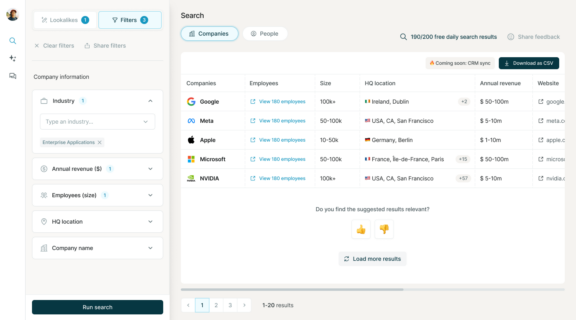Top 10 Largest Insurance Companies in the US

The pile of work waiting for you after a long weekend.
An elephant.
The universe.
All of these things are really, really big. And you know what’s even bigger than all of them?
The global insurance industry.
Ok, maybe the universe still has the edge on the insurance industry – but you get our point. Gross written premiums will amount to $9.9 trillion in value this year. That’s a lot of money.
You know what else is pretty big? The US insurance industry. In fact, it’s the largest insurance market globally – four times as big as the Chinese market, which is the second-largest one out there.
Understanding the US insurance field – and in turn, its biggest players – is really important for any sales professional working in the industry. These companies set industry trends, influence regulatory standards, and often serve as key competitors. Understand their operations and strategies, and you’ll be able to tailor your own effectively and make sure you’re approaching the right decision-makers.
You can think of learning about the biggest insurance companies in the US as building your foundational industry knowledge. This blog is going to help you do it. Here’s what we’ll be covering:
- Targeting the Largest Insurance Companies
- Finding Decision-Makers at the Top 10 Largest Insurance Companies Using Sales Navigator
- Why Surfe is a Better Solution
- So – What Are the 10 Largest Insurance Companies in the US?
Once you’ve finished reading, you’ll understand the purpose of targeting the largest insurance companies, know the best ways to do it, and have intimate knowledge of the 10 largest insurance companies in the US.
Let’s get started.
Targeting the Largest Insurance Companies
To kick things off, let’s take a look at how you’d target the largest insurance companies. Doing so will help with your own prospecting process later down the line.
Aligning with Your Ideal Customer Profile (ICP)
An ideal customer profile (ICP) is a detailed description of the type of company most likely to benefit from your product – and most likely to help your business grow. In insurance, this could include factors like company revenue, location, or specific insurance products used, to name a few.
Having an ICP is really, really important. Think about it – if you had access to a room of the top insurance executives out there, your strategy wouldn’t be to talk to each and every one in the hope that one of them closed a deal. Instead, you’d enter that room knowing exactly who you’d be best placed to talk to – and you’d also know exactly how you’d pitch it and how they’d be likely to respond.
In other words, you’d be more efficient – and be able to build more personal, trusted relationships, which, in the ultra-competitive insurance industry, is only a good thing.
With this in mind, we’re sure you understand that targeting large companies can be beneficial – but only if they match your ICP. Don’t go after the biggest fish just for the sake of it. Without a specific reason for doing so, you’ll be eaten up (sorry) by even bigger fish going for the same prize.
Largest by Revenue vs. Largest by Employees
Next up, a little on how to find your biggest potential client. Turns out, there’s more than one way to measure the size of an opportunity. If that sounds a bit weird – keep reading and we’ll explain.
Largest by Revenue: companies considered largest by revenue are those that generate the most income. Simple. This is a good thing because it indicates financial stability and a significant market presence. If your sales strategy involves targeting high-value deals, focusing on large companies can be beneficial as they’ll have bigger budgets and more complex needs – which means a higher spend on a product like yours.
Largest by Number of Employees: companies considered largest by number of employees often have a big operational scale, global reach, and potentially long, complicated decision-making processes. You know how the more people are in the kitchen, the harder it is to cook? Think of it like that. If your strategy is to target large, complex organizations, you’ll need tailored enterprise-level solutions that can handle their scale and operational intricacies. You’ll also need to keep in mind that your sales cycles will be longer.
As you can see, there’s a significant difference between the two – and the salespeople that recognize this and tailor their approaches accordingly will come out on top.
Let’s take an example. Our imaginary salesperson Tom focuses on revenue but totally blanks on categorizing his target businesses by number of employees. His solution is great for enterprise-level solutions – but not so great for the businesses that are leaner. Without this level of personalization in his approach, he wastes time targeting businesses that aren’t a good fit. No thank you.
Now we understand a little more about how to target your approach, let’s get into the nuts and bolts of how we’d actually do it.
Finding Decision-Makers at the Top 10 Largest Insurance Companies Using Sales Navigator
Ever heard of a tool called LinkedIn Sales Navigator?
Of course you have. Just in case it’s your first day ever at work, LinkedIn Sales Navigator is a tool built by the people at LinkedIn for people like you. Sales pros the world over use it to find and connect with the people they need to speak to. Here’s how.
LinkedIn has a lot of members – and LinkedIn Sales Navigator helps you narrow them down. Its powerful filtering helps you build a list of people that exactly match your ICP.
Start with the obvious – filtering by the insurance industry – and then use what else you know about your ICP to select your other filters. These could include geography, company revenue and company headcount, to name a few.
You can use LinkedIn Sales Navigator to pretty quickly build you a list of nice-looking profiles. But – and there is a big but coming – that’s pretty much where the magic ends.
Once you’ve got your list, you’re still going to have to find all their contact details (time-consuming stuff, if the list’s comprehensive) and then manually transfer all this data over to your CRM. And correct us if we’re wrong, but we’re pretty sure you don’t enjoy manually transferring data – or have the time to do it.
If only there was a solution…sigh. Wait, hang on – what’s that on the horizon?
Why Surfe is a Better Solution
Woah, looks like there’s a solution to all your LinkedIn Sales Navigator woes on the scene!
World, meet Surfe.
Surfe does everything that LinkedIn Sales Navigator can do – and more. It’s an alternative that’s going to streamline your workflows and save you loads of time. Quality data is a given, of course. Let’s take a closer look at its features.
Advanced Search Capabilities: Surfe allows you to take an ultra-targeted approach from the get-go, by searching for companies similar to those matching your ICP. If you’ve found 5 companies that match your ICP, Surfe can help you find similar companies. Just head on over to the ‘Company Lookalikes’ section to get the ball rolling. As for filtering, you can do that too. It’s got all the filter options you could ever want when building a new list of people to prospect to.
Enriched Data and CRM Integration: so, what makes Surfe really streak ahead of LinkedIn Sales Navigator? Two things: first of all, it totally removes the need for you to hunt down the contact details of people on your list. Instead, it just does it for you! Second, once it’s found those contact details, it syncs the information directly into your CRM.
Once you’ve got this data ready to go, you can start outreach immediately. That’s a million times for efficient – and removes any room for human error, too.

How Surfe’s Email Finder Works
Now, if you work in sales, it’s likely you’re a pretty curious person. How on earth does Surfe’s email finder actually make this happen?!
It’s down to a little thing called waterfall enrichment, which, if you can’t tell, we’re pretty proud of. Surfe basically aggregates the contact data from the top databases (and we mean top: think Apollo, RocketReach, Dropcontact, Hunter and People Data Labs) to give you the best chance of finding accurate contact details.
It also uses other factors, like geography, to figure out which database to work its way through first – which results in a speedy solution for you. Love it.
A quick note on emails: once Surfe has found an email address it likes the look of, it runs it through ZeroBounce to make sure your outreach won’t, you know, bounce. That’s even more time saved for you.

So – What are the 10 Largest Insurance Companies in the US?
Ok, so now you know about targeting the largest insurance companies out there and how to go about it. Now, let’s take a quick look at the 10 largest insurance companies in the US. You can use this list as inspiration for creating your own ICP-alike list.
- Liberty Mutual Insurance
Liberty Mutual is one of the largest insurers globally, offering a wide range of personal and commercial insurance products such as auto, home, and life insurance.- Annual Revenue: $500-1000M
- Cigna
Cigna is a leading global health service provider, offering health insurance and health services to individuals, employers, and government entities.- Annual Revenue: >$1000M
- State Farm Insurance
State Farm is known for its auto and home insurance, offering a wide array of personal insurance products and maintaining a strong focus on customer satisfaction.- Annual Revenue: $500-1000M
- Social Security Administration (SSA)
The SSA is responsible for administering the country’s social insurance programs, including retirement, disability, and survivor benefits.- Annual Revenue: $500-1000M
- USAA (United Services Automobile Association)
USAA provides insurance and financial services primarily for military personnel and their families, with a focus on car, home, and life insurance.- Annual Revenue: $0-1M
- Vanguard
Vanguard is known for its low-cost investment funds and financial services, catering to both individual investors and institutions.- Annual Revenue: $500-1000M
- Progressive Corporation
Progressive is one of the largest auto insurers in the U.S., well known for its innovation in policy customization and digital tools.- Annual Revenue: >$1000M
- UnitedHealthcare
UnitedHealthcare is a division of UnitedHealth Group, offering a broad range of health insurance plans and services for individuals and businesses.- Annual Revenue: $500-1000M
- Geico
Geico is famous for its auto insurance but also offers a variety of personal insurance products, including homeowners and renters insurance.- Annual Revenue: $50-100M
- The Allstate Corporation
Allstate provides car, home, and life insurance, among other products, and is known for its strong customer focus and financial stability.
-
- Annual Revenue: >$1000M
Let’s Wrap It Up!
That’s all folks! By now, you should understand what targeting the largest insurance companies in the US actually looks like – and how you can do it too. Use Surfe to keep your workflows slick and protect your time, and you’ll be onto the outreach stage in no time at all.
Insurance isn’t so big and intimidating now, is it?

Don’t let Surfe slip away!
Sign up now and you’ll be able to give it a go for free. Hello, insurance industry stardom.
FAQs About the Top 10 Largest Insurance Companies in the US
How do you Measure the Size of an Insurance Company?
As a sales professional, it’s worth taking two factors into account: size by revenue, and size per headcount. Measuring a company by these two different factors will provide valuable insights into what sales strategy you should use, and how you should approach top executives at the business.
How to Find the Email Addresses of Executives at the Largest Insurance Companies?
You can find the email addresses of executives at the largest insurance companies by using Surfe. Surfe helps you build a list of businesses that match your ICP and then finds you email addresses in just a couple of clicks -no effort from you required. As a bonus, it also then sends these right over to your CRM. Bye-bye, manual data transfer.


